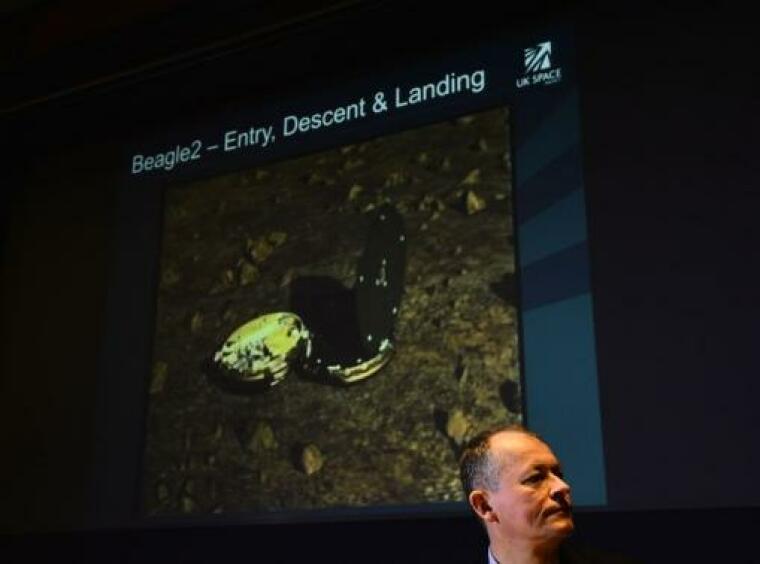NASA Finds Missing British Spacecraft On Mars 12 Years After Going MIA

The Beagle 2 has finally been found on the surface of Mars almost 12 years since it was supposed to land and start transmitting data back to Earth but did not, the U.K. Space Agency announced.
The space agency confirmed that the beleaguered spacecraft was found, thanks to the images taken by the high-resolution camera of National Aeronautics and Space Administration's Mars Reconnaissance Orbiter.
David Parker, the agency's chief executive, said images from the orbiter showed "good evidence" that the tiny Mars lander reached Mars on the date, but it was only partially deployed.
"The entry, descent and landing sequence for Beagle 2 worked and the lander did successfully touch down on Mars on Christmas Day 2003," the space agency said in a statement according to Reuters.
On Christmas Day of 2003, scientists were waiting for spacecraft Beagle 2 to land on Mars and start transmitting data back to Earth but it inexplicably went MIA instead.
After several months of not receiving communication from the British-built spacecraft, scientists declared it lost, presuming it had been destroyed during its approach or while trying to land on the red planet.
Almost 12 years after, NASA's Mars Reconnaissance Orbiter finally caught glimpse of the spacecraft after years of periodically searching for spacecraft that are missing in action like Beagle 2 and NASA's Mars Polar Lander.
The Orbiter has been circling Mars since 2006 while the Polar Lander has lost contact since it arrived at the red planet's south pole in 1999.
Officials said careful analysis of Orbiter's high-resolution photos showed the Beagle 2 had landed within its expected landing area in a basin close to the Martian equator.
Also spotting signs of key entry and descent components, Beagle 2 was discovered just 5 kilometers from its original touchdown site in the Isidis Planitia basin, The Telegraph said.
Beagle 2's mission manager, Mark Sims from Leicester University, said while the spacecraft had failed to communicate any data from Mars, it had succeeded in getting to its target, landing, and inspiring scientists.
"Overall, I would say Beagle 2 was a great success," he told the news conference at London's Royal Society scientific institution on Friday.
Measuring less than 2 meters across, Beagle 2 is a part of a European Space Agency's Mars Express mission to search for extraterrestrial life.
It was named after the ship Charles Darwin sailed when he formulated his theory of evolution. It was built by British scientists led by Colin Pillinger for about 50 million pounds ($85 million).
 Christians don't have to affirm transgenderism, but they can’t express that view at work: tribunal
Christians don't have to affirm transgenderism, but they can’t express that view at work: tribunal Archaeology discovery: Medieval Christian prayer beads found on Holy Island
Archaeology discovery: Medieval Christian prayer beads found on Holy Island Presbyterian Church in America votes to leave National Association of Evangelicals
Presbyterian Church in America votes to leave National Association of Evangelicals Over 50 killed in 'vile and satanic' attack at Nigerian church on Pentecost Sunday
Over 50 killed in 'vile and satanic' attack at Nigerian church on Pentecost Sunday Ukrainian Orthodox Church severs ties with Moscow over Patriarch Kirill's support for Putin's war
Ukrainian Orthodox Church severs ties with Moscow over Patriarch Kirill's support for Putin's war Islamic State kills 20 Nigerian Christians as revenge for US airstrike
Islamic State kills 20 Nigerian Christians as revenge for US airstrike Man who served 33 years in prison for murder leads inmates to Christ
Man who served 33 years in prison for murder leads inmates to Christ


 Nigerian student beaten to death, body burned over ‘blasphemous’ WhatsApp message
Nigerian student beaten to death, body burned over ‘blasphemous’ WhatsApp message 'A new low': World reacts after Hong Kong arrests 90-year-old Cardinal Joseph Zen
'A new low': World reacts after Hong Kong arrests 90-year-old Cardinal Joseph Zen Iran sentences Christian man to 10 years in prison for hosting house church worship gathering
Iran sentences Christian man to 10 years in prison for hosting house church worship gathering French Guyana: Pastor shot dead, church set on fire after meeting delegation of Evangelicals
French Guyana: Pastor shot dead, church set on fire after meeting delegation of Evangelicals ‘Talking Jesus’ report finds only 6% of UK adults identify as practicing Christians
‘Talking Jesus’ report finds only 6% of UK adults identify as practicing Christians Mission Eurasia ministry center blown up in Ukraine, hundreds of Bibles destroyed: 'God will provide'
Mission Eurasia ministry center blown up in Ukraine, hundreds of Bibles destroyed: 'God will provide' Church holds service for first time after ISIS desecrated it 8 years ago
Church holds service for first time after ISIS desecrated it 8 years ago Burger King apologizes for 'offensive campaign' using Jesus' words at the Last Supper
Burger King apologizes for 'offensive campaign' using Jesus' words at the Last Supper Uganda: Muslims abduct teacher, burn him inside mosque for praying in Christ’s name
Uganda: Muslims abduct teacher, burn him inside mosque for praying in Christ’s name